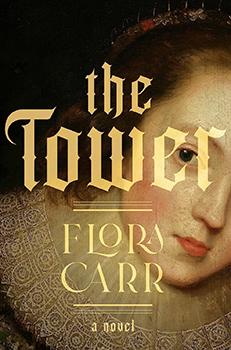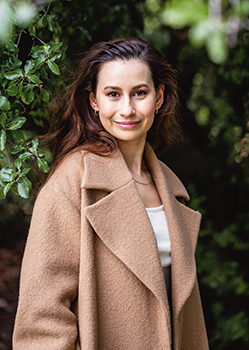

Features Flora Carr
Visiting the Women the World Never Really Knew
The Big Thrill Interviews Author Flora Carr
By K. L. Romo
 What would it be like to be held hostage in a damp, cold castle tower, isolated from everyone except for the few women kept there with you? How many secrets would you share, and how would your bond with those women become even stronger than marriage? That’s the premise in THE TOWER, Flora Carr’s debut feminist novel about Mary, Queen of Scots’ abduction and imprisonment in Scotland.
What would it be like to be held hostage in a damp, cold castle tower, isolated from everyone except for the few women kept there with you? How many secrets would you share, and how would your bond with those women become even stronger than marriage? That’s the premise in THE TOWER, Flora Carr’s debut feminist novel about Mary, Queen of Scots’ abduction and imprisonment in Scotland.
It’s 1567, and Scottish rebel lords have kidnapped Mary, Queen of Scots, and forced her to abdicate her throne.
As Carr tells us, not only is THE TOWER rife with historical accounts of Mary’s imprisonment, but at its core, it’s an “exploration of friendship.” With most societal restraints removed, the relationships between the imprisoned women revolve more around mutual respect and empathy than station.
Carr’s writing style teases us with snippets of fate yet to come—an interesting narrative feature giving readers a glimpse into the future and the fate of the characters. THE TOWER takes us into the timeless struggle of women in a man’s world—still relevant today—and sheds light on the poignant stories of women’s friendship and devotion rarely included in history books. And Carr’s sensual portrayal of the love affair between two of the women is another glimpse of intimacy not routinely addressed in narratives surrounding that time period.
The Big Thrill caught up with Carr to discuss the unique lens she used to write the story, her research, and why it is important to shine a spotlight on the complicated relationships between women throughout history.
What led you to reimagine the historical occurrences surrounding the captivity of Mary, Queen of Scots?
For a long time, Mary, Queen of Scots, has been defined either by her relationships to men—her three husbands, for example, or her ambitious half-brother—or else by her relationship to Queen Elizabeth I, a woman she never met in person. With THE TOWER, I wanted to take a different approach. I examine her relationships with her female attendants, some of whom remained with her for decades. I wanted to look at this pivotal period of Mary’s life through the lens of female friendship.
Likewise, history books have overlooked Mary’s imprisonment at Lochleven Castle in Scotland. I never knew she was imprisoned there before her flight to—and long imprisonment in—England. Yet, this short period could not have been more significant or eventful. After I stumbled across a stray reference to it, I knew I had to write about it.
How much research was required to make your novel authentic to the 16th century and historical facts? What was the hardest part of your research?
I took a multi-pronged approach to research THE TOWER. First, I read everything I could get my hands on: biographies of Mary Stuart and books about 16th-century life. I went down various research rabbit holes, including researching Tudor-era salad dressings! I also visited museums and art galleries, including the Victoria & Albert Museum in London and Holyrood Palace in Edinburgh, viewing objects Mary may well have handled in life and learning about the material culture of the period. When I embarked on THE TOWER, I was working a full-time job, so listening to academic podcasts was also great for researching while on my daily commute.
The trickiest part of my research was near the beginning when various Covid restrictions meant that while I could visit Loch Leven, there was no way of accessing Lochleven Castle, the island fortress in the middle of the loch where the book is set. I remember pacing back and forth along the shoreline, peering out at the castle ruins in desperation. Luckily, I revisited the area a second time when the castle island reopened to visitors, and by a stroke of fate, the boat in use that day was called “Mary Seton,” named after a real-life figure who is also a major character in THE TOWER.
Why did you take the approach of including ghosts as characters in the narrative?
Throughout THE TOWER, I write about the idea of royalty being tied up with the allure of the ancient—when Mary Stuart’s attendants look at her, they are also seeing all the other royals who came before her, confirming her status. In the book, I quote Saint Augustine, who wrote that the dead are invisible but not absent—and for Mary, they are ever-present.
What messages would you like readers to take away from the book?
Mary Stuart has long been a much-maligned and misunderstood figure, either depicted as a passive doomed queen or else the “whore” to Elizabeth I’s “virgin.” With THE TOWER, I wanted to present Mary as a nuanced, complex character—a charismatic person of hidden depths and contradictions—who inspired incredible levels of devotion in both men and women alike.
Similarly, women’s stories and LGBTQ stories are often erased from history, and fiction is a brilliant tool to redress that erasure and to reimagine and fill in the gaps. In fictional or on-screen portrayals of royal history, chambermaids and lower-class female attendants are often silently sewing in the background, forgotten, but THE TOWER was my opportunity to shine a spotlight on them.
Can you share a teaser about what you’re working on now?
I can’t share too much about my second novel except to say that it will be historical fiction and will again focus on women’s stories.
Tell us something about yourself your readers may not already know.
I wrote most of the TOWER in longhand first before transferring all the notes I’d made (in various battered notebooks) into a long Word document.
I was also inspired by my own childhood experience of synaesthesia when I wrote about Lady Mary Seton’s experiences in THE TOWER. Synaesthesia is a condition that causes sensory crossovers—as a child, I saw letters and numbers in colours, while Lady Seton can physically taste the colours she sees around her.
The Big Thrill Interviews Author Flora Carr
- The Big Thrill Recommends: WHAT YOU LEAVE BEHIND by Wanda M. Morris - June 27, 2024
- Sally Hepworth - May 10, 2024
- Katherine Ramsland - April 25, 2024

